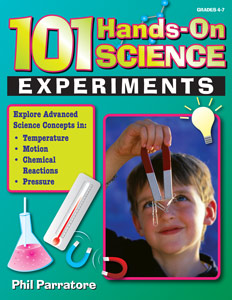I suspect that many homeschooling parents would like to do more science experiments with their children than they actually do. The time and energy parents might expend on science experiments tends to get swallowed up by reading, writing, and arithmetic as well as field trips, group classes, and sports. Yet, hands-on experiments can make a huge difference in a child’s attitude toward science. While there are many books with science experiments (and you’ve probably got some great ones sitting on a shelf somewhere), 101 Hands-On Science Experiments might actually get used. Many of the activities are super simple… you can gather what you need and complete the activity in 15 minutes or less! Of course, if you have your child write up their observations, it will take longer.
The book is written for students in grades four through seven. Experiments are rated from “1” to “4” indicating level of difficulty. Level 1 activities generally require fewer resources and are simpler to implement. But even level 4 activities are very manageable. Many are simple demonstrations rather than experiments a child will perform. While children can participate in many of the experiments, they definitely require adult supervision, and some demonstrations are probably too tricky or too dangerous for children to perform themselves even with supervision. For example, one demonstration involves soaking a dollar bill in an alcohol solution then setting it on fire; the alcohol burns but the dollar bill does not. Definitely a demonstration! On the other hand, children can get involved in constructing a bottle fountain that demonstrates the expansion of water caused by heat. Whether children perform the experiments or watch demonstrations probably won’t matter much because many of the experiments are likely to elicit “wow” reactions either way.
You should be able to find most of the required resources around the house, things like glasses, sugar cubes, a butane lighter, candles, coins, marshmallows, and hydrogen peroxide. Other items like Epsom salts, charcoal, mothballs, silicone sealant (or caulk), dry ice, and a rubber stopper might not be quite as handy, but shouldn’t be difficult to get. No specialized equipment is required. You will need to select activities and plan ahead for the items you’ll need so you can save baby food jars, Styrofoam egg cartons, and other items you usually throw away.
Each experiment is presented on only one page. Each page lists the purpose of the experiment, what topic it teaches, time required, difficulty level, materials needed, step-by-step directions, and an explanation. Explanations are relatively simple since they are for fourth through sixth grade students.
General topics addressed by these experiments are heat energy, combustion, chemical reactions, motion, force, air pressure, water pressure, temperature, solar energy, color, plants, ecology, insects, and kitchen science.
Two reproducible forms at the front of the book help you make sure students actually learn something from the experiments. Students can complete the Observation Report form to both describe and explain what they observed then connect the experiment to other scientific facts they already know. The Evaluation Rubric form helps parents or teachers evaluate student learning. I think most homeschoolers will use only the Observation Reports on a regular basis since the rubric is much more general as it evaluates skills such as “Makes inferences” and “Demonstrates the scientific method.”
101 Hands-On Science Experiments is easy to use compared to many other science experiment books, yet it teaches some fairly advanced scientific concepts, albeit at an introductory level. It will be most effective if you follow through with discussion and the Observation Reports. It would be great to correlate activities with your science curriculum, but even if not, children will be learning from the experiments. And probably even more important, children are likely to become more enthusiastic about science when they learn in this way.










